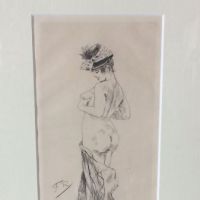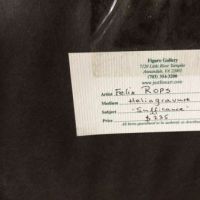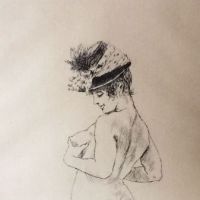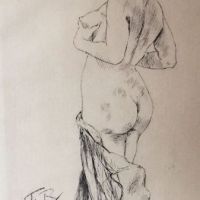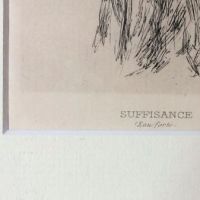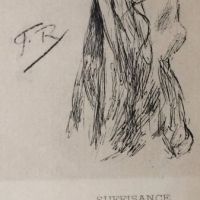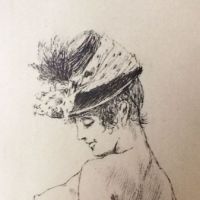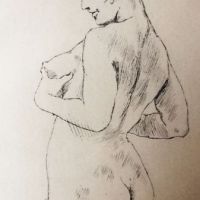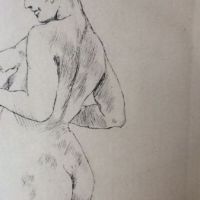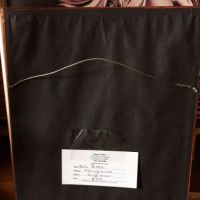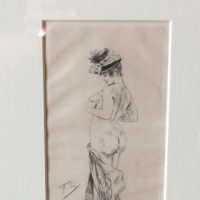⬅ Return to collection
Art : 1800s
This item has been sold
Felicien Rops Erotica Circa 1880's Titled Suffisance Felix Rops Heliogravure Print
Artist: Félicien Rops (Belgian, Namur 1833–1898 Essonnes)
Title: Suffisance
A amazing erotica image from Felix Rops. Her dress falls off of her while the young woman holds her breasts. A image you dont see that much from this time period. A very striking risque image.
Year: Circa 1880's
Signed with initials on the left side "FP"
Medium: Soft ground etching, reproduced in heliogravure
Size: framed 11 x 13 1/2
Condition: Framed and mated. Old Gallery label on the reverse.
If you have any questions or if you need additional images, pleas feel free to contact me.
THE TECHNIQUE OF TRADITIONAL HÉLIOGRAVURE:
Héliogravure is the oldest procedure for reproducing photographic images. It was first invented in the early 19th century by Joseph Nicéphore Niepce, of France, and later perfected by Talbot, Niepce de Saint-Victor, Baldus and Klic.
The process involves two distinct steps. First, in a complex photochemical procedure that creates the intaglio surface, the photographic image is fixed and etched upon a specially prepared copper plate. The finished plate is then placed on a hand-turned press, and the image is printed onto dampened etching paper using special inks.
This traditional method of héliogravure is variously called héliogravure au grain or héliogravure à plat. Before receiving the photochemical transfer of the image, the flat copper plate is first carefully dusted with rosin powder; it is then heated, so that the microscopic grains of rosin melt into fine droplets and fuse to the metal. It is this that accounts for héliogravure’s exceptional tonal range, for when the plate is subsequently etched, the acid only reaches the copper through the fine interstices existing between these grains. The transitions from light to dark are thus modulated with extreme precision and subtle nuance. Even when examined under a magnifying glass, a héliogravure betrays no screen pattern, unlike images printed using industrial methods such as offset, letterpress or rotogravure.
Title: Suffisance
A amazing erotica image from Felix Rops. Her dress falls off of her while the young woman holds her breasts. A image you dont see that much from this time period. A very striking risque image.
Year: Circa 1880's
Signed with initials on the left side "FP"
Medium: Soft ground etching, reproduced in heliogravure
Size: framed 11 x 13 1/2
Condition: Framed and mated. Old Gallery label on the reverse.
If you have any questions or if you need additional images, pleas feel free to contact me.
THE TECHNIQUE OF TRADITIONAL HÉLIOGRAVURE:
Héliogravure is the oldest procedure for reproducing photographic images. It was first invented in the early 19th century by Joseph Nicéphore Niepce, of France, and later perfected by Talbot, Niepce de Saint-Victor, Baldus and Klic.
The process involves two distinct steps. First, in a complex photochemical procedure that creates the intaglio surface, the photographic image is fixed and etched upon a specially prepared copper plate. The finished plate is then placed on a hand-turned press, and the image is printed onto dampened etching paper using special inks.
This traditional method of héliogravure is variously called héliogravure au grain or héliogravure à plat. Before receiving the photochemical transfer of the image, the flat copper plate is first carefully dusted with rosin powder; it is then heated, so that the microscopic grains of rosin melt into fine droplets and fuse to the metal. It is this that accounts for héliogravure’s exceptional tonal range, for when the plate is subsequently etched, the acid only reaches the copper through the fine interstices existing between these grains. The transitions from light to dark are thus modulated with extreme precision and subtle nuance. Even when examined under a magnifying glass, a héliogravure betrays no screen pattern, unlike images printed using industrial methods such as offset, letterpress or rotogravure.

